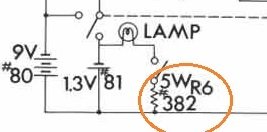Christophe1
Member
My model is different from yours, but I have the diagram of your model. And the strange part is: if I have to believe what is in the drawing, then there is a really heavy 5 watt resistor between the contact and the lamp. And if I have read this diagram correctly, it goes to ground. But an opinion of someone with insight in electronics is needed here.Following up to this, I concluded that in my case the issue is that the regulator for the lithium cell won't pass enough current to light the dial lamp -- because I'm pretty sure that lamp worked the last time I had a zinc-air cell in the meter.
The obvious solution here, if one were disassembling the unit anyway, would be to switch the dial lamp to the 9V booster circuit, replace the incandescent bulb with a similar brightness white, amber, or red LED (good arguments to be made for each), and wire in a correct current limiting resistor.











